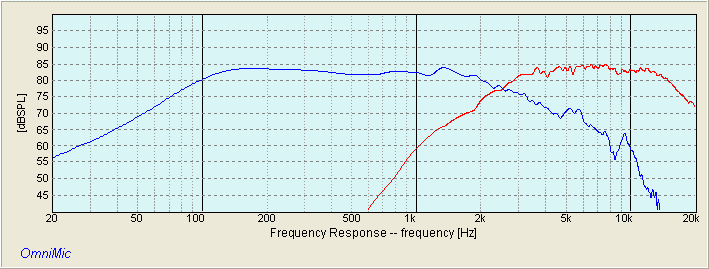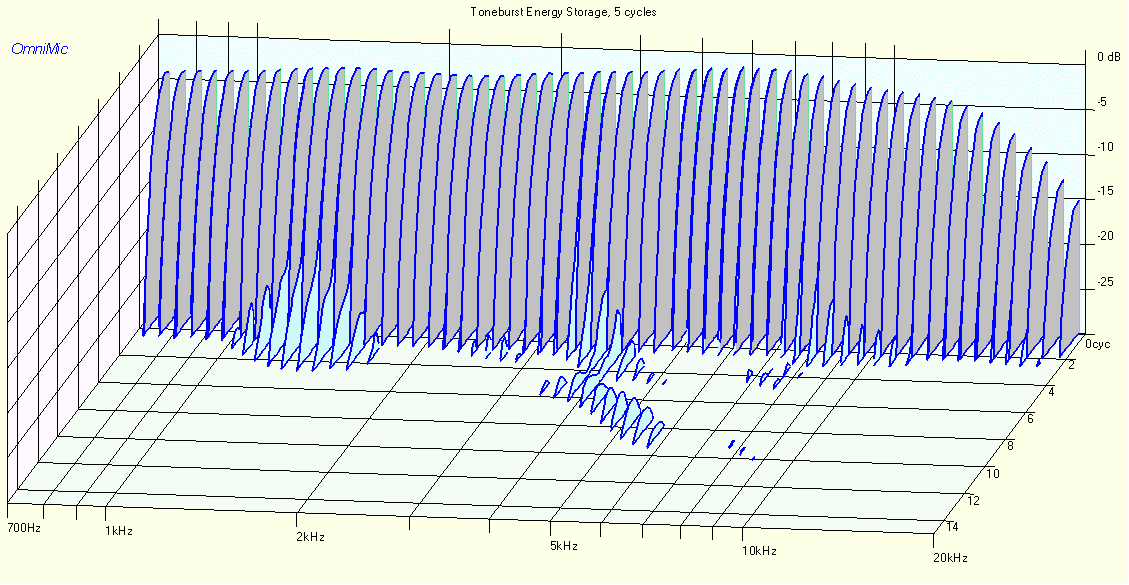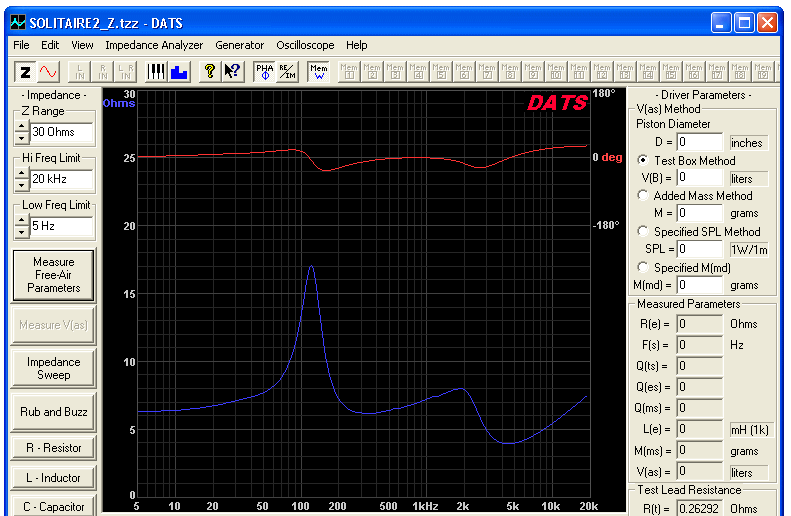|
Solitaire It’s been more than a year since I first tested out these drivers in an active, biamped system. This post is for the passive crossover.
The Red plot in Fig 1 is the response of the MDT29 with a 3rd order network. The Black plot is the RAW response, that is without the crossover.
Fig 2 shows the Peerless 830870 response with a 2nd order network. My target crossover frequency was 2.5kHz. As it turned out, the two drivers are crossing at exactly 2.5kHz.
The Black plot in Fig 3 is the summed response. The summing is flat with no cancellations observed on either side of 2.5kHz.
For clarity, I removed the responses of the 830870 and the MDT29, leaving only the Solitaire (Fig 4). The response is quite impressive. Flat all the way from 1kHz to 10kHz. Beyond that, there’s a slight dip before rolling off at 15kHz. Measurements below 500Hz are in Nearfield.
Fig 5 is with the MDT29 wired in Reversed Phase. The null response is not as deep as I would like it to be. It will take a little more work to time align the two drivers but as it stands, they are close enough not to interfere with your listening pleasure.
The Step Response in Fig 6 shows how close the MDT29 and the 830870 are. The Peerless 830870 is approximately 100 microsec behind the MDT29 tweeter. This response also shows the MDT29 crossover is a 3rd order whereas the 830870 is 2nd order.
The Solitaire Waterfall plot (Fig 7) shows some artifacts from 7kHz~10kHz. I seriously doubt they are harmful because with a time scale of 1.5msec, they are highly magnified.
The Toneburst Energy Storage plot (Fig 8) gives a clearer picture of what is happening. The artifacts from 7kHz~10kHz in the waterfall plot are hardly recorded. Looking at it another way, they died off very quickly. The excess energy that are visible are at 1.5kHz and 5kHz. Though they are recorded, they cannot be heard. Nothing to lose sleep over.
The Spectrogram in Fig 9 is a 2-D representation of the Toneburst Energy Storage. We can see that there is some energy at about 3.7kHz at the 4msec mark. Again, this is inaudible.
Fig 10 is the Harmonic Distortion of the Solitaire. The Red plot is the 2nd harmonic whereas the Violet is the 3rd. Generally, they are at -55dB below the fundamental. There is a slight rise in the 3rd harmonic from 1.5kHz~4kHz. This is from the Peerless 830870. Listening Test Wow… I’ve not heard this level of quality for quite a while. This Morel MDT29 is the sweetest tweeter I’ve come across. It’s a bit costly but if you are aiming for quality sound, it’s actually cheap. It even edge out my Seas Prestige 27TDFC and the 27TBFC. Just to recap, I designed the Solitaire as a mid-high speaker in a 3-way system. I am listening to it with a 15″ Kicker in a sealed box for the bass. The Kicker 15″ is actively crossed at 80Hz (24dB/oct). At this frequency, I cannot detect the bass bleeding into the midrange. If a passive 3-way is desired, the bass woofer will need to be crossed higher up, possibly at 250Hz~350Hz. This will keep the passive components manageable. The trade-off is the midrange will lose a bit of clarity. The consolation is most passive 3-ways are crossed at these frequencies. updated on Dec 6, 2019
The impedance of the Solitaire dips to 4Ω at 5kHz. It is therefore imperative that power amplifiers be suitably rated to avoid clipping. Note: Unless otherwise stated, all measurements were made with the mic at 36 ins, tweeter axis. Impulse Window=5ms. No smoothing applied. |

November 1, 2019Projects
 Fig 1 – Frequency Response of Morel MDT29
Fig 1 – Frequency Response of Morel MDT29 Fig 2 – Peerless 830870 (12dB/oct LPF) with Morel MDT29 (18dB/oct HPF)
Fig 2 – Peerless 830870 (12dB/oct LPF) with Morel MDT29 (18dB/oct HPF) Fig 3 – Summed Response of 830870 with MDT29
Fig 3 – Summed Response of 830870 with MDT29 Fig 4 – Solitaire Frequency Response
Fig 4 – Solitaire Frequency Response Fig 5 – Solitaire with MDT29 in Reversed Phase
Fig 5 – Solitaire with MDT29 in Reversed Phase Fig 6 – Solitaire Step Response
Fig 6 – Solitaire Step Response Fig 7 – Solitaire Waterfall
Fig 7 – Solitaire Waterfall Fig 8 – Solitaire Toneburst Energy Storage
Fig 8 – Solitaire Toneburst Energy Storage Fig 9 – Solitaire Spectrogram
Fig 9 – Solitaire Spectrogram Fig 10 – Solitaire Harmonic Distortion
Fig 10 – Solitaire Harmonic Distortion Fig 11 – Solitaire Impedance
Fig 11 – Solitaire Impedance